Algae could help fuel the future. But it's not easy being 'green'
On a patch of land between Riverview Park and the Red Mountain Freeway, two silvery metal domes tower over the Mesa wastewater treatment plant. The domes are called “anaerobic digesters,” and there are several hundred of them in the U.S.
Inside each dome, tiny organisms — bacteria — break down biological waste. But this story isn’t about bacteria. Because here in Mesa, there are some new microorganisms on the block.
Three oval-shaped ponds swirl with brilliant green water in a dirt lot below the domes. Floating in the lazy river-like current, swaths of tiny life forms glisten in the sunlight.
Algae.
Scientists in Arizona have been cultivating algae for several years, but this time, ASU researchers are working on a project with the city of Mesa in hopes of turning wastewater byproducts into fuel and other products. They want to harness the way algae naturally works to coax another use out of the gases that would otherwise be emitted as a result of the necessary process of breaking down human-produced wastewater.
The algae — more specifically microalgae, which are microscopic, single-celled organisms closely related to seaweed — take in carbon dioxide (the gas that humans breathe out) much the same way plants use sunlight, water and carbon dioxide to create their own food.
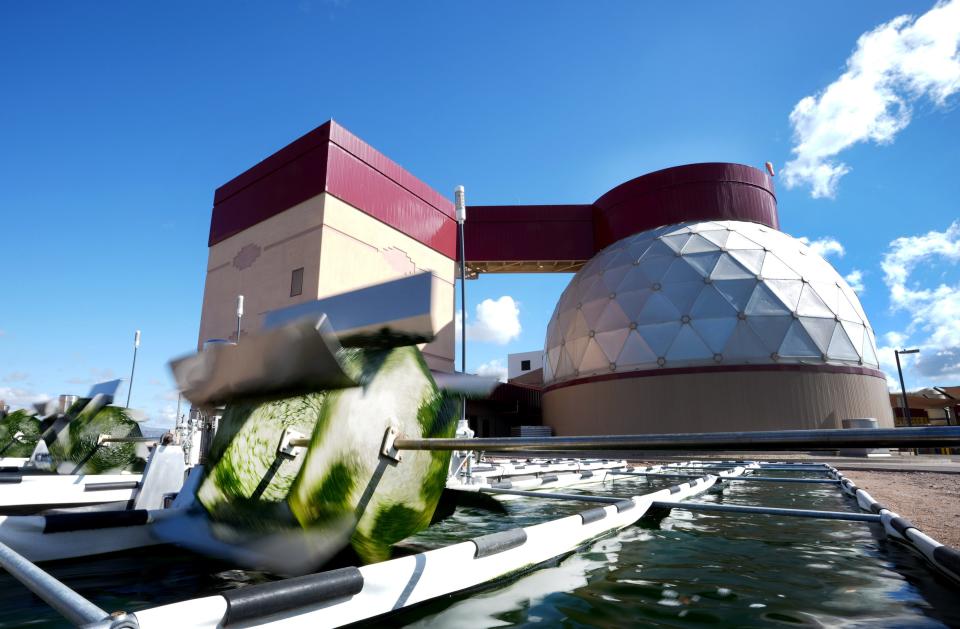
“We’re taking advantage of that. We’re using waste as food for the microalgae,” said Justin Flory, the associate director of research in the Center for Negative Carbon Emissions at Arizona State University and the manager of the algae project.
Algae-based biofuels and products have been a dream for researchers and companies for several years, including for teams at ASU and the University of Arizona. In 2007, the Energy Independence and Security Act called for 36 billion gallons of renewable fuels, including microalgae-based biofuels, by 2022. Algae biofuels are not yet produced commercially, according to the EPA.
Now, as the need for energy independence and security grow more urgent in the U.S., algae still isn’t being produced at a scale large enough to power cars, planes or anything else that requires energy. Meanwhile, many scientists say we need to electrify everything, fast, to meet climate goals, with the potential for dire consequences if we don’t.
Flory and other Arizona researchers think algae will play an important role in the move to a sustainable future. In the uncertain zone between where we are now and complete decarbonization, they say algae-based biofuels offer solutions for some of the toughest problems of the energy transition. Those include, for instance, addressing the limitations of intermittent power sources like solar and wind, reducing the impact of heavy transportation like cargo ships and, of course, improving the sustainability of unavoidable emitting processes like treating wastewater.
But for algae to reach its potential, its cultivators are up against big challenges. There are biological hurdles: Much like growers of agricultural crops on dry land, algae farmers need to achieve ideal conditions to maximize yields (and some even want to use genetic modification). Then there’s the task of converting a pond of green gunk into fuel, a design problem that engineers, chemists and other scientists are still trying to perfect.
Algae projects are most sustainable when combined with other processes, like wastewater treatment, something big companies and investors aren’t always aligned with. And beyond biology or technology, there are problems of infrastructure and policy. For algae to work, leaders and companies need to care about it.
The team at ASU, working with the city of Mesa, think they have a start on a local level. But Flory acknowledged that continued efforts of science and investment, on a local and commercial scale, will be needed to make more progress.
“It’s not something you can just flip a switch and say, we’re going to get the answer, and we’re done,” Flory said. “It takes a lot of people trying, failing, learning, (and) trying again.”
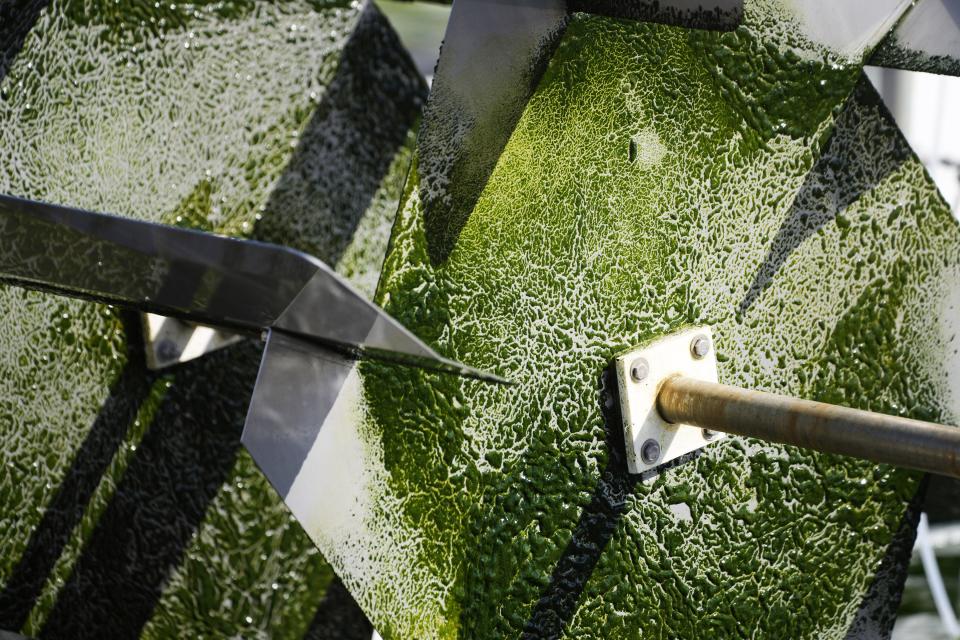
Cultivation challenges
Margarita Acedo was one of those people who wanted to keep giving algae a try. When she moved to Tucson in 2010, she had two goals.
One was to learn English, a task that took her only a few months. But the other goal was much bigger. She wanted to find better ways to cultivate microalgae to create alternative forms of energy.
Acedo, who started as a volunteer and went on to earn her master’s degree and doctorate in chemical and environmental engineering at the UA, worked at Viridos (formerly Synthetic Genomics), a California-based company that recently partnered with ExxonMobil to develop algae biofuel.
Acedo thinks the hardest part of making algae biofuels a reality will be the “transition from the lab to the field.” Before researchers can do anything with algae, they have to grow it. So Acedo has worked on projects that study the effects of light, nitrogen, heat and more on algae yields, which will be critical to understand if algae is to be grown on a commercial scale.
It might grow in water instead of a field, but she sees algae as a crop. So does Everett Eustance, an assistant research scientist at ASU who has been working with Flory on the wastewater project.
“Here (on our project at ASU), they keep track of it, make sure it’s growing healthy. You have to make sure the fertilizers and everything is correctly done just like any other farm crop,” Eustance said.
And much like farmers, algae cultivators won’t be able to control the weather. That, Acedo says, is a gap that needs to be addressed between research and reality.
“All of what we (were) producing (was) at the R&D stage,” Acedo explained of her time at Viridos, “so most of the things (algae researchers are) producing is data."
Another decision for researchers growing algae, including Arizona teams, is whether to grow algae in environments that are open or closed to the outside world. To grow the vast amounts of algae needed to produce biofuels on a large scale, cultivators need big ponds. Smaller, closed systems tend to work well, but the size is limited, and they’re more expensive. When ponds are outside, wind could contaminate the algae or introduce dust.
“You can grow them in closed reactors, but they’re a lot more capital intensive. You need a ton of landmass to be able to cultivate enough algae to make a huge dent in your biofuels,” said Kimberly Ogden, professor and department chair of chemical and environmental engineering at UA. Ogden was Acedo’s Master’s and doctoral advisor while Acedo was a student and has been focused on biofuels and bioproducts for over a decade.
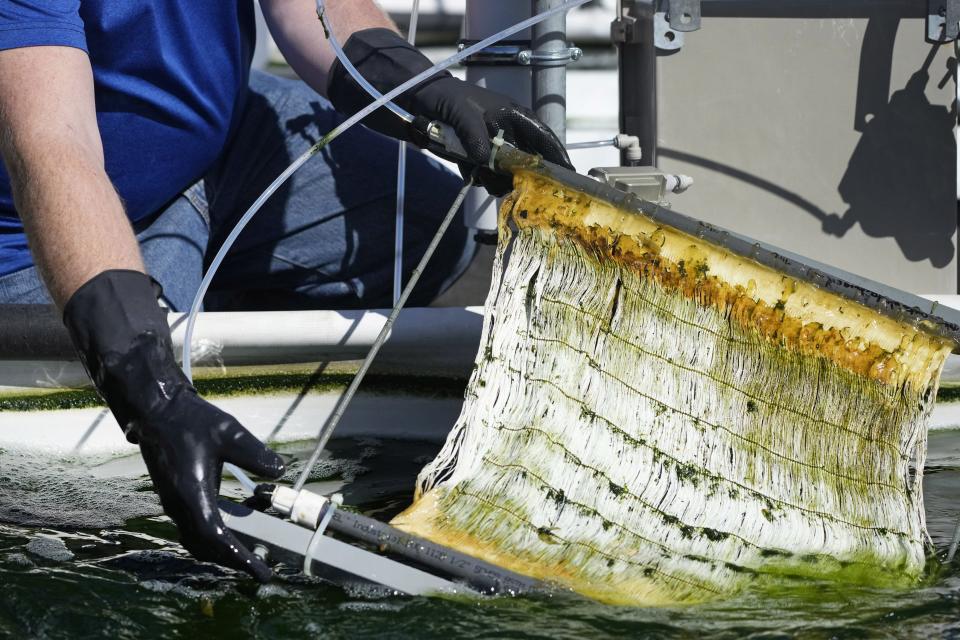
One solution to the space problem? Trying to increase the amount of oil the algae produces. Acedo says that’s a project other scientists have been working on at Viridos. Just as land-based farmers might use a genetically modified crop variety that produces higher yields, algae researchers are applying similar techniques to try to get more biofuel bang for their buck.
Learn about Arizona agriculture: How a desert plant's DNA could help save Arizona's farm crops in a changing climate
In the meantime, bright sunny places like California and Arizona remain important for studying algae growth.
“Arizona is a great place for (algae cultivation) because of how much sunlight we have,” Ogden said. But in the desert, water usage is a big concern. “At some point we might get a water problem, because there’s a lot of evaporation off of there."
That’s something Flory and his team hope to address by working directly with a wastewater plant. Since the process already involves reclaimed water, it’s less of a burden on water systems.
“If you’re attaching them to wastewater treatment plants, that’s a good idea,” said Ogden, who was not involved with the ASU project.
But even with the right algae strains and the growing location set up, there’s more work to be done to make microalgae fuel viable.
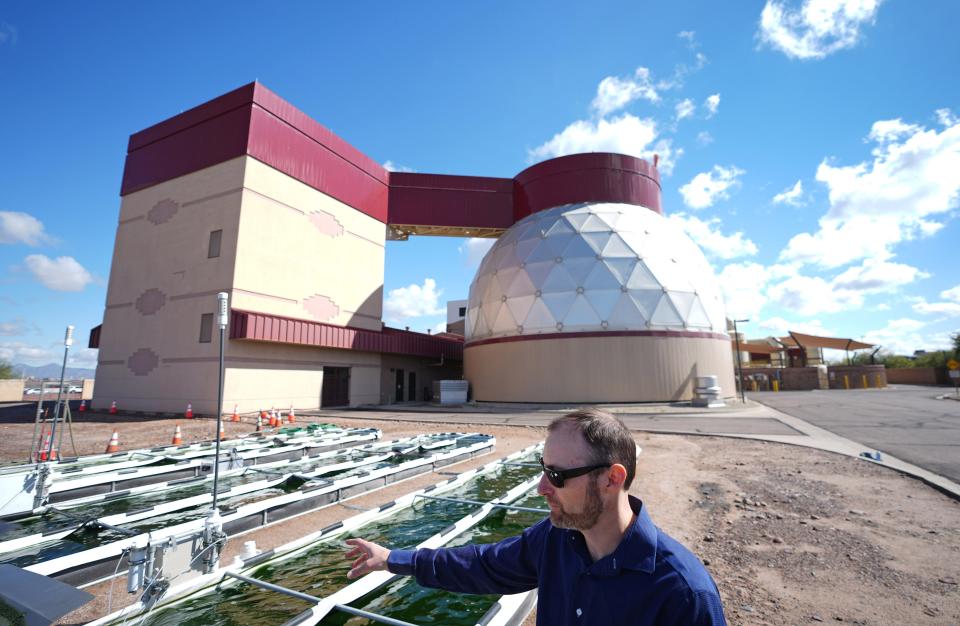
Scaling up: The role of infrastructure and integration
At one of the ponds at the Mesa site, Eustance dips a gloved hand into the green water. He pulls out something that looks like a woven rug, or maybe old parchment: a square mat made up of long, white fibers connected at each end with a length of metal.
This is where the magic happens.
When the microalgae “eat” the waste from the anaerobic digesters, they do two useful things. They leave behind a purer form of methane (another type of gas) that can be pumped into existing natural gas systems as “renewable natural gas.” And they also grow more of themselves, creating “biomass,” which can eventually be converted into biodiesel or other products like fish feed or even synthetic materials used to make sneakers.
But to get that waste from the metal dome into the algae ponds, scientists need a go-between.
“They’re like little hollow drinking straws, but very small. And that lets the carbon dioxide … get delivered to the microalgae,” Flory explained. “What comes out the end of those drinking straws is the methane, which you can use as natural gas.”
The natural gas you're most familiar with is probably the kind that formed deep underground, as a result of plant and animal matter decomposing under pressure over millions of years. Extracting it often involves building deep wells or fracturing rock formations at high pressure in a process commonly called fracking.
This natural gas is different. It ultimately serves the same purpose as other natural gas, and it still emits carbon dioxide into the atmosphere when it’s burned for fuel, but it didn’t take millennia to form. And in this particular case, because it’s attached to a wastewater plant, it’s getting two uses out of the same greenhouse gases that would be emitted no matter what as a result of the waste in wastewater breaking down.
“It’s a way of separating the carbon dioxide from the methane and using (the methane) for a productive purpose,” Flory said.
That separation is important because methane is a particularly harmful driver of climate change. Both carbon dioxide and methane are so-called greenhouse gases, which trap heat in the atmosphere and drive the warming of the planet. But methane is about 28 times more potent than carbon dioxide, according to an assessment from the Intergovernmental Panel on Climate Change.
If methane gets separated out and burned as fuel before being emitted, it breaks down and releases carbon dioxide (it’s not perfect, researchers say, but it’s a lot better than releasing methane). For that to happen, Flory says he and his team are working on making those special gas-delivery fibers more efficient. Going into the fibers, there’s about 40% carbon dioxide and 60% methane. Flory estimates that right now, by the time the algae is done with it, it’s closer to 85% methane.
Flory is aiming for an even better 97% methane.
Recent research news: 'A tipping point': Arizona universities join forces to map the deadly Valley fever fungus
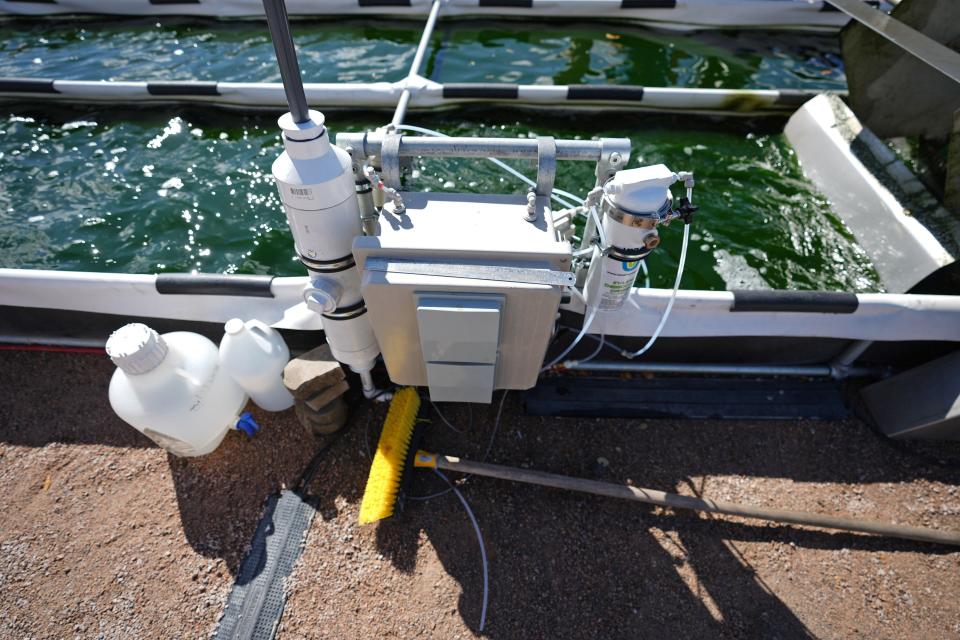
It’s all part of a plan to make their system as cheap and efficient as possible. That includes reducing the energy needed to create the current needed for the algae by using the paddle wheels attached to the ponds.
To tackle those infrastructure challenges, researchers need more investment that will allow them to fine-tune a relatively new process.
“One of the biggest challenges we have compared to corn ethanol or any other terrestrial (biofuel crop)? We don’t have the existing infrastructure,” said Eustance, noting that farmers on land already had everything in place they needed to cultivate plants like corn. “Right now, it’s tricky. There’s a lot of unknowns, too, because we’re still very much (on) the small scale.”
Acedo understands why companies like ExxonMobil might be necessary to transition from that small scale to commercial-scale projects. “We need the money of an investor,” she said.
But she isn’t necessarily convinced that oil and gas companies like Exxon will be interested in integrating algae infrastructure on a local level with projects like wastewater treatment, something that Arizona researchers, both on and separate from the ASU project, agreed would be important for the highest climate impact.
Acedo described how energy companies, similar to ExxonMobil, have been cultivating large algae ponds in Europe, with what she believes is the aim of diversifying an energy portfolio commercially rather than with a focus on sustainability.
“When you are actually integrating different processes, like wastewater treatment … that’s when you make it more sustainable,” Acedo said.
Casey Norton, a spokesperson for ExxonMobil, did not answer when asked about whether the company was working on integrating processes like wastewater treatment as part of its algae biofuel strategy. Instead, he described the work with Viridos on developing genetic tools for better cultivation, as well as other biofuel projects not using algae, which some scientists have pointed out have the potential to be land-intensive and inefficient.
“Algae is one part of our portfolio approach to researching, developing and deploying lower-emissions technologies,” he said in an email.
Other bioscience news: You caught a virus and recovered. But what happens when that virus stays inside you forever?
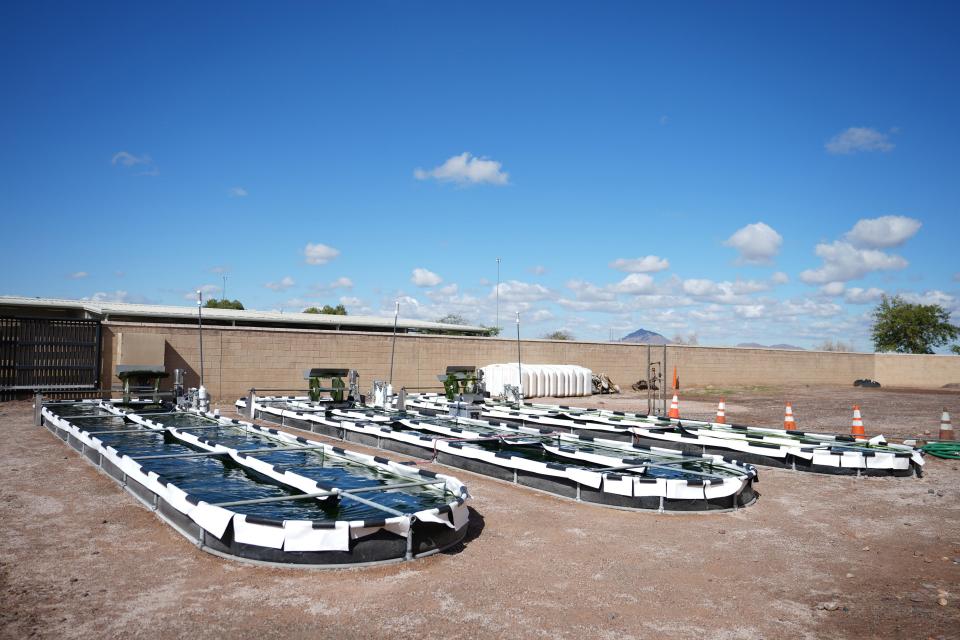
A mindset shift
Even though some big companies might see financial green when they look at algae, Flory says he thinks most people, if they have heard of it at all, see algae as a nuisance, something that blooms in recreational areas, kills fish and generally makes life more difficult.
That hasn’t stopped scientists like him from communicating about the allure of algae as an innovative climate solution. “It’s pretty in some ways, it’s got beautiful colors to it. I think most people don’t really know much about what it is,” Flory said.
But with that beauty comes a reality: As literally green as algae may be, it will take a bigger paradigm shift for investments in algae energy to pay off, both economically and environmentally.
John Giles, the mayor of Mesa, is optimistic about the algae project, which he touts as an investment in innovation. And he thinks that innovation will be non-negotiable if climate goals are to be achieved.
“Last year, we adopted a climate action plan that is very aspirational, but also we want it to be achievable,” said Giles, noting that he believes Mesa’s plans are on par with those of cities across the world.
“We don’t know how we’re going to do this (attain climate action goals), but we’re going to set these goals and we’re going to hope the technology evolves,” he said, adding that “the technology we need to achieve these goals doesn’t exist.”
The lag between technology and implementation is a roadblock facing the energy sector as a whole and part of the reason Flory thinks biofuels will be needed to make the transition to cleaner energy sources possible.
“The reality is today we can’t easily go to 100% (renewables) because so far, we don’t have the capacity to really do that,” he said, citing technology challenges involved in storing intermittent power sources like solar and wind.
Ogden agrees that there won’t be one solution to the energy challenges of the future, and thinks “we’re a long way off from not using any carbon to do things” She noted that algae-based biofuels are of particular interest for airplanes and cargo ships, which have not yet been electrified.
Unless there’s a carbon tax or the market changes significantly, she says fossil fuels will continue to be too much cheaper than renewable sources for there to be any economic incentive for decarbonization.
That’s why Flory hopes that integrating their project with wastewater treatment, which he says has always been a burden for society as well as for the climate, will help the technology gain traction. Though wastewater treatment only accounts for 1% of Mesa’s overall carbon footprint as outlined in their climate action plan, it’s also something that society has already agreed needs to be paid for, an idea that’s been slower to catch on for carbon emissions.
“Ultimately, it comes down to, ‘is carbon dioxide emissions enough of a problem that we think we should pay for it in some regard?’” Flory said. “I think we’re going to need those (kinds) of policies and (a) mind shift to make (algae biofuels) really scalable.”
Independent coverage of bioscience in Arizona is supported by a grant from the Flinn Foundation.
Melina Walling is a bioscience reporter who covers COVID-19, health, technology, agriculture and the environment. You can contact her via email at mwalling@gannett.com, or on Twitter @MelinaWalling.
This article originally appeared on Arizona Republic: Algae could fuel planes, ships and cars. But challenges remain

